By Doug Winter – RareGoldcoins.com
CoinWeek Content Partner……….
As recently as a few years ago, I was wondering why San Francisco gold coins weren’t as popular as I thought they should have been (a blog from one year ago, for example). But a combination of factors has quickly turned the market for certain San Francisco gold coins, and still other factors bode well for the future popularity of nearly all gold coins from this facility.
Why have San Francisco gold coins gone from unpopular to popular in a relatively short period of time? I think there are a few factors at play.
 The first is obvious: rarity has really become en vogue in the coin market in the last few years, and it is hard to argue with the fact that most pre-1878 San Francisco gold coins are both absolute and condition rarities. You don’t have to suspend disbelief when, for example, you look up the number of coins graded at PCGS for 1860-S eagles and you see a whopping 23 graded (and assuming the typical number of resubmissions, this might equate to as few as 15 separate examples). Many new collectors have become attracted to coins which are rare not just because a piece of plastic says so.
The first is obvious: rarity has really become en vogue in the coin market in the last few years, and it is hard to argue with the fact that most pre-1878 San Francisco gold coins are both absolute and condition rarities. You don’t have to suspend disbelief when, for example, you look up the number of coins graded at PCGS for 1860-S eagles and you see a whopping 23 graded (and assuming the typical number of resubmissions, this might equate to as few as 15 separate examples). Many new collectors have become attracted to coins which are rare not just because a piece of plastic says so.
The second is less obvious: I see younger collectors coming into the rare date gold market and these individuals tend to not want to buy the coins that their parents were attracted to. Which, in certain cases, means out with the southern branch mint coins and in with the western mints. If you think about it, Charlotte and Dahlonega coinage has reigned supreme in dated gold popularity circles for over 25 years. Maybe it’s just time the pendulum swung somewhere else, and San Francisco coins became popular as a result.
The third is simultaneously obvious and not obvious: the various shipwrecks full of San Francisco double eagles have focused considerable attention on large-sized coins from this mint, and the newly-discovered Saddle Ridge Hoard is likely to do this yet again. Does the typical collector who buys an 1857-S S.S. Central America double eagle in MS65 suddenly take an interest in 1857-S gold dollars or quarter eagles? Probably not, but you can certainly make the connection between the new interest in San Francisco gold with all the publicity these finds have generated in both the pre-internet and internet eras.
The Saddle Ridge Hoard motivated me to provide readers with a basic guide to San Francisco gold coins of all denominations, and to provide some collecting tips as well.
Before we look at each denomination and type, a couple of things need mentioning for beginning collectors. The San Francisco mint opened in 1854 and struck gold coins, with occasional interruptions, until 1930. Gold coins were struck in the following denominations: dollars, quarter eagles, three dollar gold pieces, half eagles, eagles, and double eagles.
Gold Dollars
Type One (1854 only)
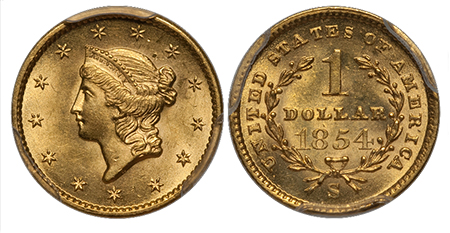
The 1854-S dollar is a one-year type which saw a mintage of 14,632. It is common in circulated grades and available from time to time in the lower Mint State grades. It becomes rare in MS63 to MS64, and Gems are extremely rare. There are probably two or three known in MS65, and the best I have personally seen is the Pittman I: 863 coin, now graded MS65 by PCGS, which was recently sold to a California specialist; it brought $33,000 back in its 1997 auction appearance. I like this issue a lot and find it to be much undervalued, given its numismatic significance as a dual first-year-of-issue and one year type.
Type Two (1856)
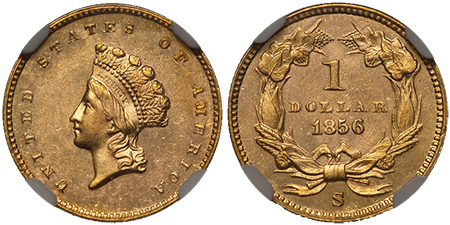
The ill-fated Type Two gold dollar design was introduced in 1854, but it didn’t reach the San Francisco mint until 1856; a year in which the Philadelphia and Dahlonega mints were already striking dollars with the new Type Three design.
The 1856-S dollar is a common issue in circulated grades and a surprisingly high number exist from the original mintage of 24,600. It is moderately scarce in the lower Uncirculated grades, rare in properly graded MS62 to MS63, and very rare above this. I have never seen a Gem, and maybe four or five in MS64 which I thought were choice. The current auction record for this date is $52,875, set by an NGC MS64 with CAC approval which sold as Heritage 2/13: 3910.
There are two varieties known for this date: the normal mintmark, and the visually impressive S/S which is actually the most common of the pair.
The 1856-S is another numismatically significant issue which is a one-year type.
Type Three (1857-1860 and 1870)
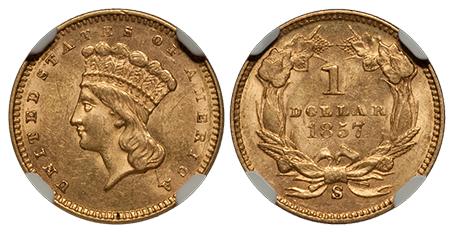
Type Three dollars were made at the San Francisco mint for just five years, including a ten year gap between the fourth and the final issue. The first four issues all have reasonably similar mintages (between 10,000 and 13,000) and similar rarity profiles. All are usually seen in EF45 to AU55 grades and are very scarce in the lower Mint State grades. Most are exceedingly rare in MS63 and above, and non-existent in Gem. The 1870-S has a mintage of only 3,000 coins but it is more available than its earlier counterparts, especially in comparatively high grades.
The Type Three gold dollars from San Francisco are very affordable and a nice About Uncirculated set could be assembled for around $10,000. I think these coins are very undervalued, especially in properly graded MS61 and above.
Liberty Head Quarter Eagles (1854-1863, 1865-1873, 1875-1879)
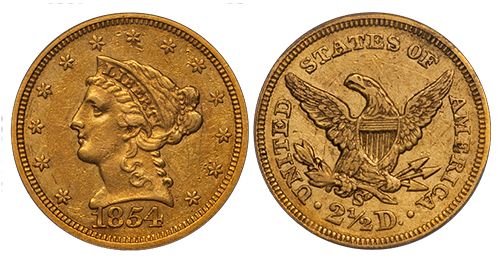
The quarter eagles from this mint begin with the second rarest gold coin ever produced in San Francisco: the 1854-S. A mere 246 were struck, and there are an estimated dozen or so known with the single finest of these grading AU50 at PCGS. For many years, the 1854-S quarter eagle was a neglected Classic Rarity. Prices began to appreciate around ten years ago and have risen since, but I still feel that the 1854-S is an undervalued coin compared to other less rare 19th and 20th century issues.
The other San Francisco quarter eagles from the pre-Civil War years are less interesting (and far more available) than the 1854-S. The Civil War issues themselves are scarce with the low mintage (8,000 struck) 1862-S leading the way.
The 1865 through 1873 issues form one of the more undervalued groups in all of American numismatics. These coins are certainly not rare in circulated grades, but nice AU coins are typically available in the $1,500-2,500 range and these represent excellent value. Most of these dates are even available, from time to time, in the lower Uncirculated and are still comparably affordable.
This denomination was terminated by the San Francisco mint after 1879. Today, quarter eagles from this mint are not terribly popular with collectors. This could very easily change and a nice quality set, minus the rare 1854-S, is still within reach of the collector with an average budget. In fact, if I were a collector with a budget of around $2,500 per coin, I would seriously look at specializing in San Francisco quarter eagles.
Three Dollar Gold Pieces (1855-1857, 1860 and 1870)

Production of this odd denomination was a seeming afterthought at the San Francisco mint with only one issue, the 1856-S, having a significant original mintage figure. The four obtainable San Francisco three dollar gold pieces are all reasonably obtainable in EF and the lower AU grades, but all are scarce in properly graded AU55, rare in AU58, and very rare in Uncirculated.
The rarest collectible three dollar gold piece from this mint is the 1855-S with an original mintage of just 6,600. It is a numismatically significant issue due to its status as a first-year issue, but unlike its counterparts the 1854-O and 1854-D, it is not a one-year type and it is not as popular as the two southern coins. The 1855-S is exceedingly rare in Uncirculated and there is a single Proof known which brought $1,322,500 in Heritage’s 8/11 auction.
The 1870-S is a unique issue which is in the ANA Museum. It was purchased by Harry Bass from the Eliasberg sale in October 1982, and when it next becomes available, it will shatter all prices records for a gold coin from the San Francisco mint.
As far as collecting this series goes, it is short-lived and fairly easy to complete with just four issues (not including, of course, the unique 1870-S). For $30,000 or so, a nice AU set could be assembled. An Uncirculated set is possible, but it would be very challenging, especially if the collector is careful to avoid coins graded MS60 and MS61 which are debatable as to their “newness.”
Liberty Head Half Eagles
a. No Motto, 1854-1866

The thirteen coin San Francisco No Motto Liberty Head half eagle is a very challenging set. Only one or two coins (the 1856-S and 1857-S) are reasonably easy to find in collector grades and every date in this series is, at the very least, rare to extremely rare in the higher AU grades.
The kingpin of this set, and arguably the most valuable gold coin ever struck at this mint is the 1854-S. Only 268 were made, and just three are known today with one in the Smithsonian Institution and the others in private collections. The finest of the three is the Eliasberg coin, currently owned by a Texas collector, which could bring $4-5 million or more if offered for sale today.
The next rarest No Motto half eagle from this mint is the 1864-S of which an estimated 30 or so are known including one gem PCGS MS65+ example which is ex Norweb/Bass.
Many of the San Francisco No Motto half eagles are either unknown or unique in Uncirculated, and even the reasonably common 1856-S and 1857-S are very rare in Uncirculated with just three or four known for the former and seven to nine for the latter.
For many years, demand for the rare No Motto half eagles from San Francisco languished. This was due to a combination of factors including conspicuous overgrading of available coins by the services, the lack of published references, inflated values in published price guides, and more.
Around three or four years ago, No Motto half eagles from San Francisco became more popular. Interestingly, prices rose from the bottom up. I began noticing coins like 1858-S half eagles in VF25 and 1860-S half eagles in VF30 selling for very strong prices at auction, especially if they were in PCGS holders, choice and original for the grade, and eye appealing for the issues. Coin like 1858-S or 1860-S half eagles graded AU55 haven’t quite shown this level of appreciation, but this tends to be because most of the coins of this caliber are not CAC quality.
b. With Motto, 1866-1888, 1892-1906

The With Motto half eagles from San Francisco can basically be divided into two distinct groups: the rare (and mostly) interesting issues from 1866 to 1876 and the available (and mostly) uninteresting issues from 1877 to 1906.
The motto IN GOD WE TRUST was added to the reverse of the half eagle denomination in 1866 but no before dual varieties were produced at the San Francisco mint. 9,000 of the No Motto half eagles were struck compared to 34,000 of the With Motto coons and the latter are more available.
My favorite “sleeper” date from this era is the 1867-S which is rarer than its mintage of 29,000 would suggest. There are only 60-80 known in all grades, and I have never seen one above AU55. Despite this issue’s obvious scarcity, it is affordable and I recently sold a pleasing PCGS EF45 for just a hair over $3,000.

The 1876-S is the single rarest With Motto half eagle from this mint. Only 4,000 were produced and this date is not often seen above AU50. It is unique in Uncirculated with the Garrett coin having been graded MS64 by PCGS; nothing else known comes close.
Beginning in 1877, mintage figures increase for half eagles from San Francisco and by the end of the 1880’s, they sometimes exceed 1,000,000 coins. Many of the San Francisco half eagles from the 1880’s, 1890’s and early 1900’s exist in significant quantity in grades up to MS64 and the high mintage 1901-S is common even in Gem Uncirculated.
The “sleeper” issue for the late dates from San Francisco is the 1894-S. It has a much lower mintage than the other post-1878 dates. This date is not often seen above MS62 although an amazing NGC MS69 (ex Clapp/Eliasberg) is known; it recently sold for $176,250.
The With Motto half eagles from this mint are not as popular with collectors as the No Motto issues. This means that there are some great values in this sub-set, especially in the 1867-1876 date range. The later dates are currently of interest primarily to type collectors but it is certainly possible that they may receive more focus from date collectors in the future.
Indian Head Half Eagles (1908-1916)
The attractive incuse Indian Head design was created by Bela Lyon Pratt and it was used on both the quarter eagle and half eagle denomination. The San Francisco mint produced half eagles using this design from 1908 through 1916.
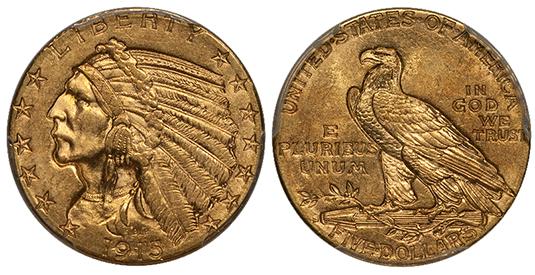
There are no great rarities in the nine-coin Indian Head half eagle set from San Francisco, unlike the eagles and double eagles from this era. All of the San Francisco issues of this type can be easily found in AU grades and even in the lower Mint State range at reasonably affordable prices. These issues tend to become scarcer (and expensive) in the MS63 to MS64 range and nearly all are very rare in MS65.
Indian Head half eagles tend to be collected in one of two ways: in affordable AU58 to MS62 grades or in challenging MS64 to MS66 grades. In the case of the former, the San Francisco specialist will have an easy time. In the case of the latter, he will be greatly challenged as dates like the 1913-S and 1915-S are extremely rare in Gem.
Liberty Head Eagles
a. No Motto, 1854-1866

Unlike its quarter eagle and half eagle counterparts, the Liberty Head eagle series contains no stoppers like the 1854-S from both denominations. That said, the No Motto eagles from San Francisco contain many very dates and one—the 1864-S—which has finally been recognized as a truly rare issue.
The 1854-S eagle is an interesting issue as it has a comparatively high mintage of 123,826 and it is rather easy to locate in EF and lower AU grades. The real “sleeper” among the early San Francisco eagles is the 1855-S with a mintage of just 9,000. This date is unknown in Uncirculated and very rare in AU. Other early dates from this mint which are rare to very rare include the 1859-S and the 1860-S.
I mentioned the 1864-S eagle in the opening paragraph of this section and I think some more comments are in order about this date. Of the 2,500 struck, there are likely no more than 25-30 known. For close to a decade, most of the available specimens were sold to one collector and now that his collection is being sold, price records for this date are being shattered. Heritage recently sold a PCGS EF45 for $117,500 and it is likely that this price will be eclipsed if a nicer example is made available in the coming months.
Despite the great fanfare that the 1864-S eagle has recently received, other rare issues in this series remain fairly priced. I am a big fan of the 1860-S but I like the Civil War issues as well. With the exception of the 1854-S, 1856-S and 1857-S, virtually all of these No Motto issues are nearly unobtainable above AU50, especially with original color and choice surfaces.
b. With Motto (1866-1889, 1892-1903, 1904-1907)
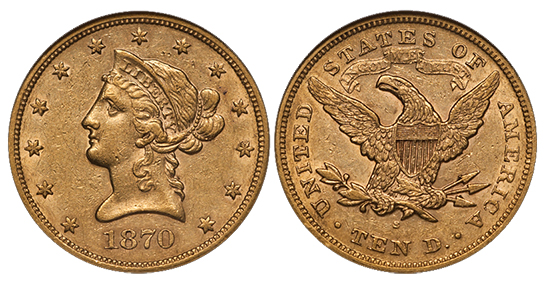
As with the half eagles from this mint, there are two distinct rarity profiles for San Francisco With Motto eagles. The coins struck from 1866 through 1878 tend to be very scarce to rare in all grades and virtually impossible to find in Uncirculated. while the post-1878 dates were struck in greater quantities and are much more available. In fact, the 1901-S has the highest mintage figure of any Liberty Head eagle and it is the single most available date of this type to locate in MS65 to MS66 grades.
The top “sleeper” dates in the With Motto series? In the earlier dates, I like the 1870-S and the 1876-S (although this second date is not really a secret any longer) and in the later dates, I like the 1894-S and 1895-S; two issues which are very scarce in Uncirculated.
It is feasible to collect the With Motto San Francisco eagles by date as there are no stoppers and many of the later issues can be found in comparatively high grades. While this type hasn’t really been much collected by date, perhaps the discovery of some interesting With Motto San Francisco eagles in the Saddle Ridge Hoard might spur interest.
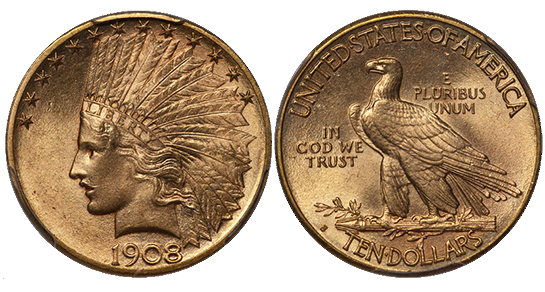
Augustus St. Gaudens’ Indian Head design was introduced on the eagle denomination in 1907, but the first San Francisco coins were not struck until 1908. They were produced without interruption through 1916, then in 1920 and 1930.
The two rarest San Francisco issues of this type are the 1920-S and 1930-S. Both were heavily melted and didn’t see much in the way of circulation. The 1920-S is the rarer of the two and it is extremely rare in higher grades. The finest known is the famous PCGS MS67 from the Duckor collection that realized $1,725,000 in March 2007. The finest known 1930-S is also graded MS67 by PCGS and it realized $299,000 in a January 2009 auction.
A date which is not as well-known is the 1913-S. This is the true “condition rarity” among San Francisco eagles of this design. It is only moderately scarce in the lowest Uncirculated grades but it is rare in MS63, and Gems are extremely rare. The finest known is an NGC MS67 (formerly graded MS66 by PCGS) which brought $299,000 in 2009, and $287,500 in 2007.
A Gem set of San Francisco Indian Head eagles would be extremely difficult to complete and very expensive as well. A set in MS63 to MS64 (with a few Gems included) is more feasible, but certainly not an easy accomplishment.
Liberty Head Double Eagles
a. Type One, No Motto (1854-1866)

For a variety of reasons, Type One Liberty Head double eagles are the single most avidly collected series of gold coins from the San Francisco mint. These coins are big, they can be found in relatively high grades, they are affordable, and only two issues—the 1861-S Paquet and the 1866-S No Motto—are hard to locate.
The first year of issue, the 1854-S, is a curious coin. It is reasonably available in higher grades but nearly every known example has matte surfaces from exposure to seawater. High-grade examples with original surfaces are extremely rare.
Many dates of this type are plentiful in Uncirculated due to shipwrecks such as the S.S. Central America, S.S. Brother Jonathan, and the S.S. Republic. Nearly every serious collector has seen or may even own a nice Uncirculated 1857-S double eagle from the Central America. There were thousands of choice to gem examples of this date, and they spurred considerable interest in other San Francisco double eagles and shipwrecks coinage in particular.

The rarest Type One double eagle from this mint is the 1861-S Paquet Reverse. A total of 19,250 were struck but most were melted and an estimated 100 or so are known today, mostly in EF40 to AU50. This issue is unknown in Uncirculated, and most seen have very heavily abraded surfaces, poor luster and negative eye appeal.

Another interesting variety is the 1866-S No Motto. 120,000 were struck before orders were received to changeover to the new With Motto reverse. Many were melted but this variety has lately become very popular with collectors. A PCGS MS62+ from the Saddle Ridge Hoard is the new finest known and this is likely to be the single most highly valued and sought-after coin from this treasure.
Type One doubles from San Francisco are popularly collected by date. With the exception of the 1854-S, 1861-S Paquet, and 1866-S No Motto, all eleven coins can be obtained in nice AU grades for four figure prices. This set could not be completed in Uncirculated due to the current status of the Paquet and most high-budget collectors “settle” for an AU55 or AU58 example.
b. Type Two, With Motto (1866-1876)
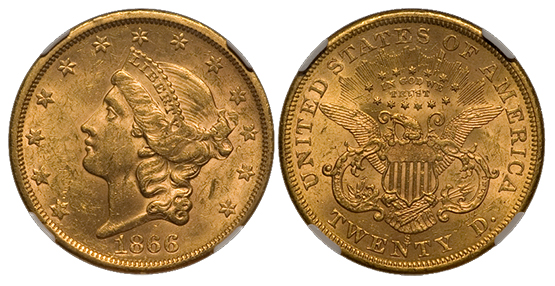
The 11 coin set of Type Two Liberty Head double eagles is very popular as well and, unlike the Type One series mentioned above, it can be completed in Uncirculated grades. The two rarest San Francisco Type Two issues in higher grades are the 1866-S With Motto and the 1867-S. Both of these are seldom seen above MS60 to MS61 and are characterized by heavily abraded surfaces and soft strikes.
A few of the Type Two San Francisco issues are relatively plentiful in MS62 to MS63 and, as a result, they are popular with type collectors. These include the 1875-S and the 1876-S.
The “sleeper” date of this type is the 1873-S Closed 3 which is an issue almost never seen above MS60 to MS61.
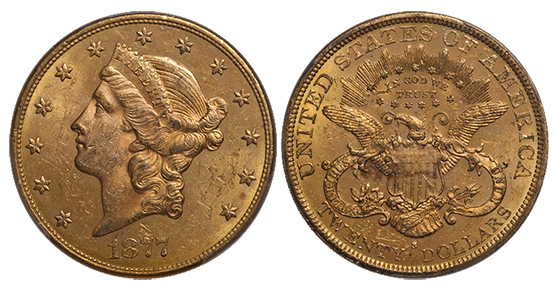
Type Three San Francisco issues are typically divided into two groups: those from 1877 to 1881 which are condition rarities and the later issues which tend to be far more available, even in higher grades.
The 1877-S through 1881-S double eagles are all extremely scarce above MS62 and mostly unknown (at least until the discovery of some exceptional pieces in the Saddle Ridge hoard) in Gem Uncirculated. These dates tend to be extremely abraded hence the reason most are graded AU58 to MS61 by the services.
The Type Three double eagles from 1882 onwards are found a bit more often in MS63 and even MS64 grades but nearly all dates are rare to very rare in MS65.
This is an easily completable series which should see the most immediate benefit from the Saddle Ridge Hoard due to the fact that most of the coins in this 1,400+ piece group were of this type. Some dates, such as the 1889-S and 1890-S, are suddenly far more available in MS64 and MS65 than before as a result of discoveries from the hoard but these coins are likely to be quickly absorbed into the market.
St. Gaudens With Motto (1908-1911, 1913-1916, 1920, 1922, 1924-27, 1930)
The beloved St. Gaudens double eagle was produced in huge quantities at the San Francisco mint. Dates range from very common to very rare.
The San Francisco double eagles which are hard to find are rare as a result of heavy meltings. As an example, there were 558,000 double eagles made at this mint in 1920 but the survival rate is low and today the 1920-S is represented by fewer than 300 coins. In Gem, this date is extremely rare with probably no more than four or five known.
The single rarest St. Gaudens double eagle from this mint is the 1930-S. It has the lowest mintage of any date from San Francisco except for the 1908-S (which was saved as a first year of issue) and around 125-150 are known, mostly in the MS62 to MS64 range.
Collectors don’t typically specialize in San Francisco Saints as they tend to focus on either the whole series if they have big ambitions, or they dabble in the series with occasional forays into the higher grade type coin realm and/or slightly better dates.
So there you have it. In around 4,000 words an encapsulation of the various types and designs of San Francisco gold coinage, with pieces ranging from super common to exceedingly rare (and even in the case of the 1870-S $3.00, unique).
I personally feel that the future for better quality gold coins from this mint is rosy. I’ve seen a strong influx of new collectors into this area of the market, and prices have risen accordingly. But there are many undervalued, sleeper issues that are as good a value as anything in the U.S. gold coin market.
About Doug Winter
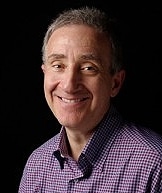 Doug has spent much of his life in the field of numismatics; beginning collecting coins at the age of seven, and by the time he was ten years old, buying and selling coins at conventions in the New York City area.
Doug has spent much of his life in the field of numismatics; beginning collecting coins at the age of seven, and by the time he was ten years old, buying and selling coins at conventions in the New York City area.
In 1989, he founded Douglas Winter Numismatics, and his firm specializes in buying and selling choice and rare United States coins, especially US gold coins and all branch mint material.
Recognized as one of the leading specialized numismatic firms, Doug is an award winning author of over a dozen numismatic books and the recognized expert on US Gold. His knowledge and exceptional eye for properly graded and original coins has made him one of the most respected figures in the numismatic community and a sought after dealer by collectors and investors looking for professional personalized service, a select inventory of impeccable quality and fair and honest pricing. Doug is also a major buyer of all US coins and is always looking to purchase collections both large and small. He can be reached at 214-675-9897.
Doug has been a contributor to the Guidebook of United States Coins (also known as the “Redbook”) since 1983, Walter Breen’s Encyclopedia of United States and Colonial Coins, Q. David Bowers’ Encyclopedia of United States Silver Dollars and Andrew Pollock’s United States Pattern and Related Issues
In addition he has authored 13 books on US Gold coins including:
- Gold Coins of the New Orleans Mint: 1839-1909
- Gold Coins of the Carson City Mint: 1870 – 1893
- Gold Coins of the Charlotte Mint: 1838-1861
- Gold Coins of the Dahlonega Mint 1838-1861
- The United States $3 Gold Pieces 1854-1889
- Carson City Gold Coinage 1870-1893: A Rarity and Condition Census Update
- An Insider’s Guide to Collecting Type One Double Eagles
- The Connoisseur’s Guide to United States Gold Coins
- A Collector’s Guide To Indian Head Quarter Eagles
- The Acadiana Collection of New Orleans Coinage
- Type Three Double Eagles, 1877-1907: A Numismatic History and Analysis
- Gold Coins of the Dahlonega Mint, 1838-1861: A Numismatic History and Analysis
- Type Two Double Eagles, 1866-1876: A Numismatic History and Analysis
Finally Doug is a member of virtually every major numismatic organization, professional trade group and major coin association in the US.
If you are interested in buying or selling classic US coins or if you would like to have the world’s leading expert work with you assembling a set of coins? Contact Doug Winter at (214) 675-9897 or by email at [email protected].




